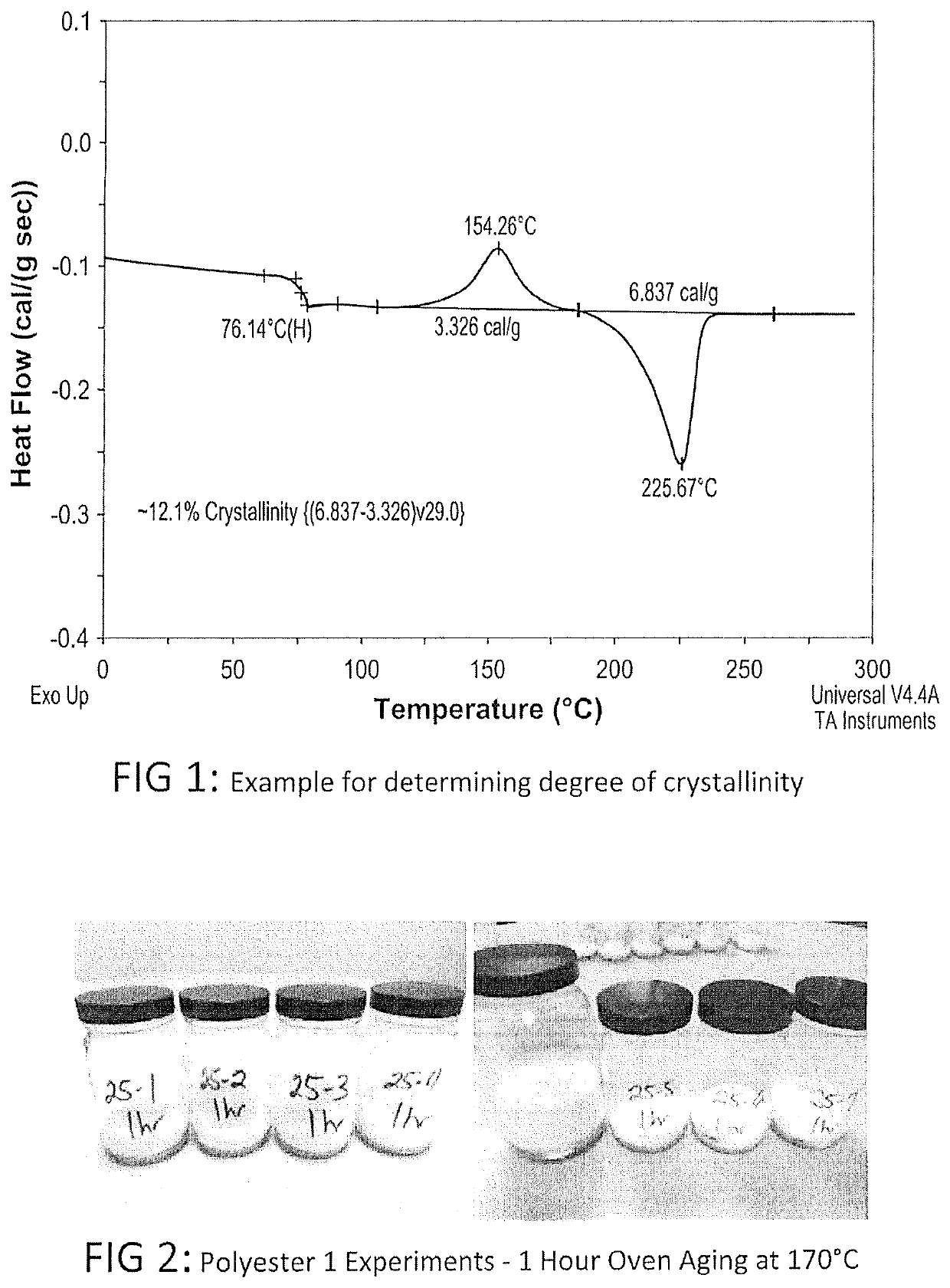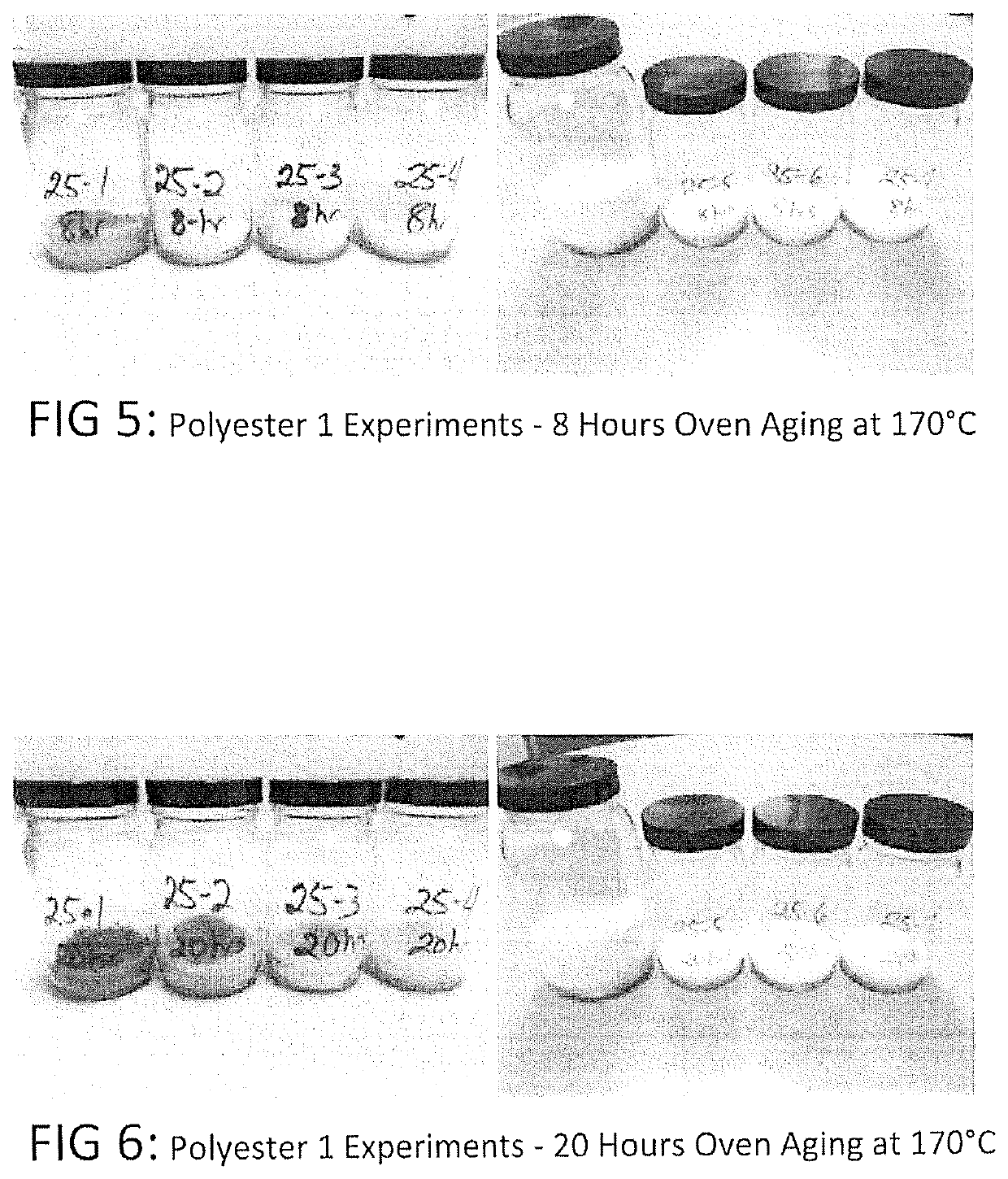Polymer compositions having improved properties of thermal stability, color, and/or flow
- Summary
- Abstract
- Description
- Claims
- Application Information
AI Technical Summary
Benefits of technology
Problems solved by technology
Method used
Image
Examples
example 1
[0293]Table 1 above contains compositions studied, gel permeation chromatography results and color difference data. Four different formulations were investigated, control formulation with 100% Polyester 1, a formulation with 0.25% Irganox 1010, 0.125% Irgafos 168, and 99.625% Polyester 1, a formulation with 0.5% Irganox 1010, 0.25% Irgafos 168, and 99.25% Polyester 1, and a formulation with 1.0% Irganox 1010, 0.5% Irgafos 168, and 98.5% Polyester 1. After the aging protocol in the forced air oven, the results show that molecular weights (number average (Mn), weight average (Mw) and higher average molecular weight (Mz) decreased less with higher loadings of Irganox 1010 and Irgafos 168. Yellowness (b* and db*) and total color difference (dE) all generally changed less with higher loadings of Irganox 1010 and Irgafos 168. There was some difficulty in obtaining accurate color data as some of the powder samples fused together and resulted in some inconsistent measurements, but FIGS. 1 t...
example 2
[0294]Table 2 above contains compositions studied, gel permeation chromatography results and color difference data. Three different formulations were investigated, a formulation with 1.0% Irganox 1010, 0.5% Irgafos 168, 0.6% Joncryl 4468 and 97.9% Polyester 1, a formulation with 1.0% Irganox 1010, 0.5% Irgafos 168, 1.0% Joncryl 4468 and 97.5% Polyester 1, and a formulation with 1.0% Irganox 1010, 0.5% Irgafos 168, 1.4% Joncryl 4468 and 97.1% Polyester 1. After the aging protocol in the forced air oven, the results show that molecular weights (number average (Mn), weight average (Mw) and higher average molecular weight (Mz)) all increased with higher loadings of Irganox 1010 and Irgafos 168. Only color readings were taken at after 20 hours of oven aging. Yellowness (b* and db*) and total color difference (dE) all generally decreased with higher loadings of Irganox 1010 and Irgafos 168. There was some difficulty in obtaining accurate color data as some of the powder samples fused toge...
example 3
[0295]Table 3 above contains the results of a pilot plant scale up including gel permeation chromatography results and color difference data. One formulation was run based on Runs 2 and 3 and consisted of 1.0% Irganox 1010, 0.5% Irgafos 168, 0.5% Joncryl 4468 and 98.0% Polyester 1. A control formulation with no additives was run as a comparison. The composition was compounded on a production size twin screw compounding extruder at 215° C. Extruded strands were immediately cooled in a water bath and then pelletized. Samples were aged in a forced air convection oven set at 175° C. for 24 hours. The GPC data shows that the formulation with Irganox 1010, Irgafos 168 and Joncryl retained molecular weight and had a minimal amount of color change. FIG. 5 visually shows the difference in the two formulations.
PUM
| Property | Measurement | Unit |
|---|---|---|
| concentration | aaaaa | aaaaa |
| temperatures | aaaaa | aaaaa |
| weight % | aaaaa | aaaaa |
Abstract
Description
Claims
Application Information
 Login to View More
Login to View More - R&D
- Intellectual Property
- Life Sciences
- Materials
- Tech Scout
- Unparalleled Data Quality
- Higher Quality Content
- 60% Fewer Hallucinations
Browse by: Latest US Patents, China's latest patents, Technical Efficacy Thesaurus, Application Domain, Technology Topic, Popular Technical Reports.
© 2025 PatSnap. All rights reserved.Legal|Privacy policy|Modern Slavery Act Transparency Statement|Sitemap|About US| Contact US: help@patsnap.com



